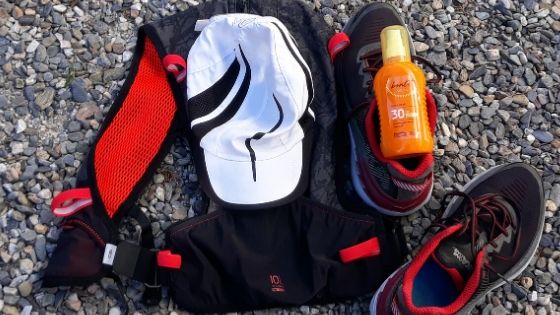
I was chatting to my friend Anabel after the finish of the final 10k of the summer season, congratulating her on making yet another podium finish. I noticed that her face and neck were showing distinct sunburn and asked her why she wasn’t using sunblock. Her answer surprised me: “I never use sunblock when I race. The cream blocks my sweat and makes be overheat, slowing me down.”
This was the first I had heard about sunblock causing overheating, so I took to Google to find answers.
Does sunblock make you trail-run slower? There is no evidence to support the theory that sunblock increases the overheating effect of trail running in the direct sun. In three different studies, there was no impact on the key performance indicators of core temperature, sweat loss, heart rate, or oxygen consumption.
Hot conditions can cause a domino effect of problems for you out on the trails. No matter how fast or slow you are, overheating will slow you down and may even bring you to a complete stop before the end of your long run. While we now know that sunblock will not impact any of the key physical performance areas of your running, there are more subtle nuances that we will need to examine.
Busting The Myth
Before we get into the science that refutes the claim that sunscreen clogs up your pores and causes you to overheat, let’s take a look at where this theory may have originated.
I remember the first aid course that I did as part mountain guide certification. One of the modules covered how to treat burns. At the time there was a home remedy myth that rubbing butter on the area of the burn would soothe the skin and “draw out” the burn.
We were taught that this was both false and dangerous. Rubbing butter on the burn area would seal the heat inside the skin allowing the burn to continue damaging skin tissue. Better was running cold water over the affected area or submerging the burn area into an ice bath.
So it is easy to see how this theory spilled over into the realm of sunblock. However, unlike a burn wound, creamy sunblock will not be trapping heat inside your body causing you to overheat. When you are out in the scorching sun, the greatest source of heat will be from both the sun and the heat radiating back at you from the trail and surrounding rocks. Sunblock will be a protective barrier against both.
In fact, all three clinical studies show that there is no negative impact on the key factors that determine your running performance. All of the test subjects in the clinical studies showed no adverse change in core temperature, sweat rate, heart rate or oxygen consumption.
In fact, some of the higher SPF sunscreen lotions that were tested caused a lowering of skin temperature, rather than the increase that was expected.
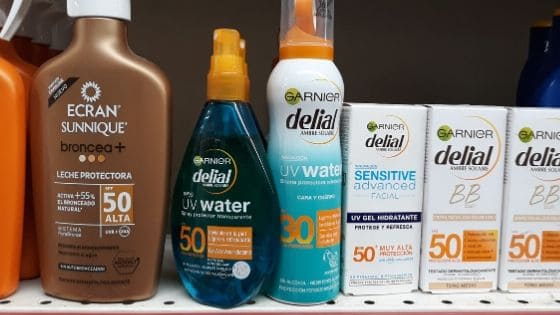
Skin Temperature Changes Caused By Sunscreen
The earliest study into the effects of sunscreen on athletes’ body heat was published in the Physician and Sportsmedicine journal in 1984 by Thomas D. Wells Ph.D., George T. Jessup Ph.D., and Kathy S. Langlotz M.Ed. The online version of the research paper was released on 12 May 2016.
In the study, sixteen well-trained athletes were required to exercise for a period of 39 minutes in both hot and humid conditions as well as hot and dry conditions. In each of those two scenarios, the athletes were required to exercise with mildly protective sunscreen (SPF8) applied to any exposed skin.
The study found no significant variance in heart rate, sweat loss or oxygen consumption between the two tests. The only variance worth noting was that all athletes showed increased skin temperature after exercising in the hot and dry conditions.
From this the Wells group to conclude that it was the sunscreen that had caused an increase in athlete skin temperature.
What the Wells study of 1984 omitted was testing the athletes without any sunscreen applied. If they had done this it would have eliminated the possible conclusion that it was simply the hot and dry conditions that caused the athletes’ skin temperature to increase, independent of the presence or not of the sunscreen.
In addition, some of the subjects drank water during their exercise while others did not. This could easily have skewed the data on core temperature.
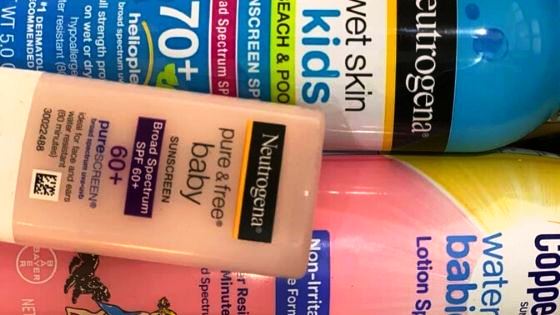
How Sunscreen Affects Body Heat
Following the 1984 study using very mild SPF8 sunscreen, the thought was that perhaps it was that the sunscreen impeded the evaporation of sweat, which caused the increase of skin temperature in the hot and dry conditions.
However, that theory fell flat for two reasons. Humid conditions are known to impede the evaporation of sweat. Yet in the hot and humid conditions, there was no increase in skin temperature. Secondly, there was no increase in the core temperature of the athletes. Changes in core temperature would be a more reliable way to prove that the athletes were unable to regulate their body heat through sweating.
These were the main flaws with the 1984 study highlighted by Declan Connolly’s Ph.D. thesis at Oregon State University completed in 1994.
How Sunscreen Affects Athletic Performance
In order to mitigate the flaws in the Wells study, Connolly conducted his own clinical experiment where he meticulously equalized variables but for the sunscreen lotion.
Where the Wells study had each athlete pushing out 100 Watts on the stationary bike which failed to adjust for different fitness levels, the Connolly study had each athlete pushing 55% of their personal VO2 max effort.
Where the Wells study allowed athletes to drink to thirst, the Connolly study used blood plasma analysis to ensure that athletes were not only well hydrated but also hydrated to the same level for each test.
The temperature was set at a fraction under ninety degrees (32C) with a 54% relative humidity to simulate what in general would be considered to be hot and dry conditions.
In order to isolate for sunscreen only, each athlete underwent the test twice, once while wearing SPF15 sunscreen and once not wearing any sunscreen. It would have been better if the test had been placebo-controlled but it was certainly a lot better than the 1984 test.
Unlike the Wells study in 1984, Connolly had ten years of technology improvements to use for his experiment.
Twenty-two male athletes were selected for the test and each was required to push 55% of their VO2 max for 40 minutes following a five-minute warm-up.
Aside from mean skin temperature, Connolly also tested for changes in ventilation, rectal temperature (core temperature), oxygen consumption, lactate levels, sweat loss, percent plasma volume change, rating of perceived exertion, and respiratory exchange ratio.
The super interesting aspect of the whole experiment was each and every one of the performance-related markers above that was tested showed no negative impact from using sunscreen.
However, when it came to the skin temperature measurement the results were rather unexpected.
Rather than the anticipated skin temperature increase that was shown by the Wells study that used weaker SPF8 sunscreen, the Connolly experiment using SPF15 sunscreen showed a lowering of skin temperature. In fact, at the conclusion of the experiment athlete skin temperature was lower than the ambient temperature.
What the Connolly study shows us is that it is not the sunscreen that caused the athletes’ skin temperature to increase in the Wells study, it was that skin temperature reacts differently to humid and dry conditions.
The study also affirmed that the use of sunscreen had no adverse effect on athletic performance.
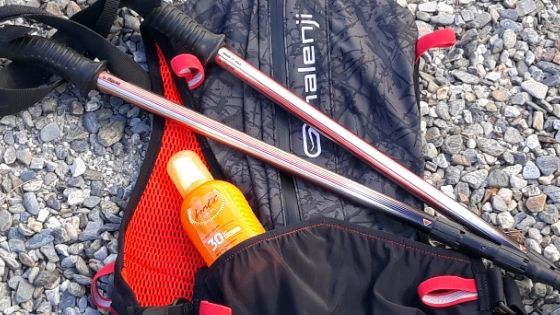
Even The US-Military Got Involved
It stands to reason that the US-military would be interested in the impact of sunscreen use on physical performance. They need to ensure that there is not a notable drop off in physical capacity as it could have catastrophic outcomes for whole teams of troops in desert conditions.
Very little is known about the base data in the military study as those documents are currently classified. What is known is that the subjects were working at 60% of their VO2max for 60 minutes. The outcomes were consistent with the Connolly study.
How Sunburn Makes Training And Racing Harder
Now that we have seen that sunscreen has no negative impact on your athletic performance, it raises the question of what will happen if you skip on the sunscreen?
The obvious answer is that you are likely to get a sunburn. Depending on how badly burned you are, your discomfort level will range from mild to severe.
I know that from personal experience that a bad sunburn makes it near impossible to head out into the direct sun for more training or racing till I have dealt with my sunburn. There have been times where I was sidelined for 5 days after a bad sunburn.
Let’s take a closer look at sunburn and how it impacts your athletic performance beyond the mere irritated skin type discomfort, irritation, and distraction levels.
As you become sunburned white blood cells are diverted to your skin to help clean up the UV damaged skin cells. As a way of getting more white blood cells to your skin capillaries will swell up and fluid will leak into the surrounding skin tissue. In severe cases, capillaries may burst, causing even more fluid to leak into your skin.
This is what causes the swollen, red and painful skin. Sunburned skin needs protein, glycogen, and oxygen for the process of repair and regrowth. Ironically this is exactly what your muscles also need in order to recover from the effort of your trail run.
Simply put, resources that your body uses to repair sunburn damage cannot be used for your athletic recovery. Therefore your recovery will be notably slower.
Slow recovery will have a knock-on effect on your future training sessions resulting in the accumulation of more and more fatigue.
Something else that I have learned from experience is that a sunburn makes it more difficult to get enough restful sleep. That, too, negatively impacts my ability to recover from my workouts.
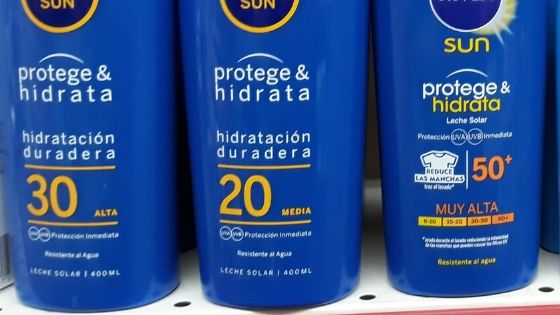
No discussion on the subject of sunburn, UV radiation and sunscreen can be complete without acknowledging the proverbial elephant in the room.
A study by Jolieke C. van der Pols Ph.D. et al in Queensland, Australia, that was published in 2006 looked into the long term use of sunscreen to combat skin cancer.
Half of all the cancers in the United States are skin cancers. Regular daily use of sunscreen as mild as only SPF15 can lower your risk of developing squamous cell carcinoma (SCC) by about 40 percent, and cut your melanoma risk by 50 percent.
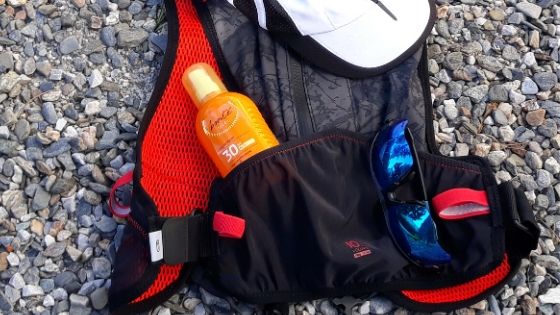
How I Deal With Sunscreen In My Eyes
When I am out running on the trails I tend to sweat a lot. By “a lot” I mean to the level of where the sweat drips from my nose and chin.
As you can imagine, sweat in my eyes is a very common occurrence. When that sweat is mixed with sunscreen it burns like crazy!
So necessity being the mother of invention I have come up with a solution to the problem of sunscreen in my eyes. My partner came up with an idea that even managed to prevent sweat from getting into my eyes as well.
If I put sunscreen on my forehead it is a foregone conclusion that most or that sunscreen will land up in my eyes as I sweat. My solution is to only put sunscreen on my face from eye-level down. That choice puts my forehead at risk of sunburn. Therefore, I always run with a wide-brimmed cap and my UV protection sunglasses.
The cap also keeps a fair amount of sweat away from my face which is a bonus.
The final piece of the sweat into my eyes puzzle solution was an idea that came from my partner. At first, I was highly skeptical about whether it would work at all. But I gave it a try and to my surprise, it has worked well.
Her idea was that I put vaseline on my eyebrows as a way to channel the rivulets of sweat away from my eyes and down my cheeks. I already have a pot of vaseline on my aid station drop-bag list for possible chaffing issues so this is just a new use for something I already have.
If you sweat anywhere near as much as I do and battle the burn of sunscreen in your eyes, give these ideas a try.
